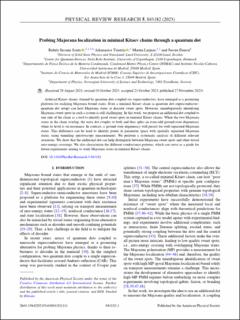| dc.contributor.author | Souto, Rubén Seoane | |
| dc.contributor.author | Tsintzis, Athanasios | |
| dc.contributor.author | Leijnse, Martin | |
| dc.contributor.author | Danon, Jeroen | |
| dc.date.accessioned | 2024-03-04T10:11:48Z | |
| dc.date.available | 2024-03-04T10:11:48Z | |
| dc.date.created | 2023-12-18T09:34:54Z | |
| dc.date.issued | 2023 | |
| dc.identifier.citation | Physical Review Research (PRResearch). 2023, 5 (4), . | |
| dc.identifier.issn | 2643-1564 | |
| dc.identifier.uri | https://hdl.handle.net/11250/3120844 | |
| dc.description.abstract | Artificial Kitaev chains, formed by quantum dots coupled via superconductors, have emerged as a promising platform for realizing Majorana bound states. Even a minimal Kitaev chain (a quantum dot–superconductor–quantum dot setup) can host Majorana states at discrete sweet spots. However, unambiguously identifying Majorana sweet spots in such a system is still challenging. In this work, we propose an additional dot coupled to one side of the chain as a tool to identify good sweet spots in minimal Kitaev chains. When the two Majorana states in the chain overlap, the extra dot couples to both and thus splits an even-odd ground-state degeneracy when its level is on resonance. In contrast, a ground-state degeneracy will persist for well-separated Majorana states. This difference can be used to identify points in parameter space with spatially separated Majorana states, using tunneling spectroscopy measurements. We perform a systematic analysis of different relevant situations. We show that the additional dot can help distinguish between Majorana sweet spots and other trivial zero-energy crossings. We also characterize the different conductance patterns, which can serve as a guide for future experiments aiming to study Majorana states in minimal Kitaev chains. | |
| dc.language.iso | eng | |
| dc.rights | Navngivelse 4.0 Internasjonal | |
| dc.rights.uri | http://creativecommons.org/licenses/by/4.0/deed.no | |
| dc.title | Probing Majorana localization in minimal Kitaev chains through a quantum dot | |
| dc.title.alternative | Probing Majorana localization in minimal Kitaev chains through a quantum dot | |
| dc.type | Peer reviewed | |
| dc.type | Journal article | |
| dc.description.version | publishedVersion | |
| dc.source.pagenumber | 0 | |
| dc.source.volume | 5 | |
| dc.source.journal | Physical Review Research (PRResearch) | |
| dc.source.issue | 4 | |
| dc.identifier.doi | 10.1103/PhysRevResearch.5.043182 | |
| dc.identifier.cristin | 2214653 | |
| cristin.ispublished | true | |
| cristin.fulltext | original | |
| cristin.qualitycode | 1 | |

